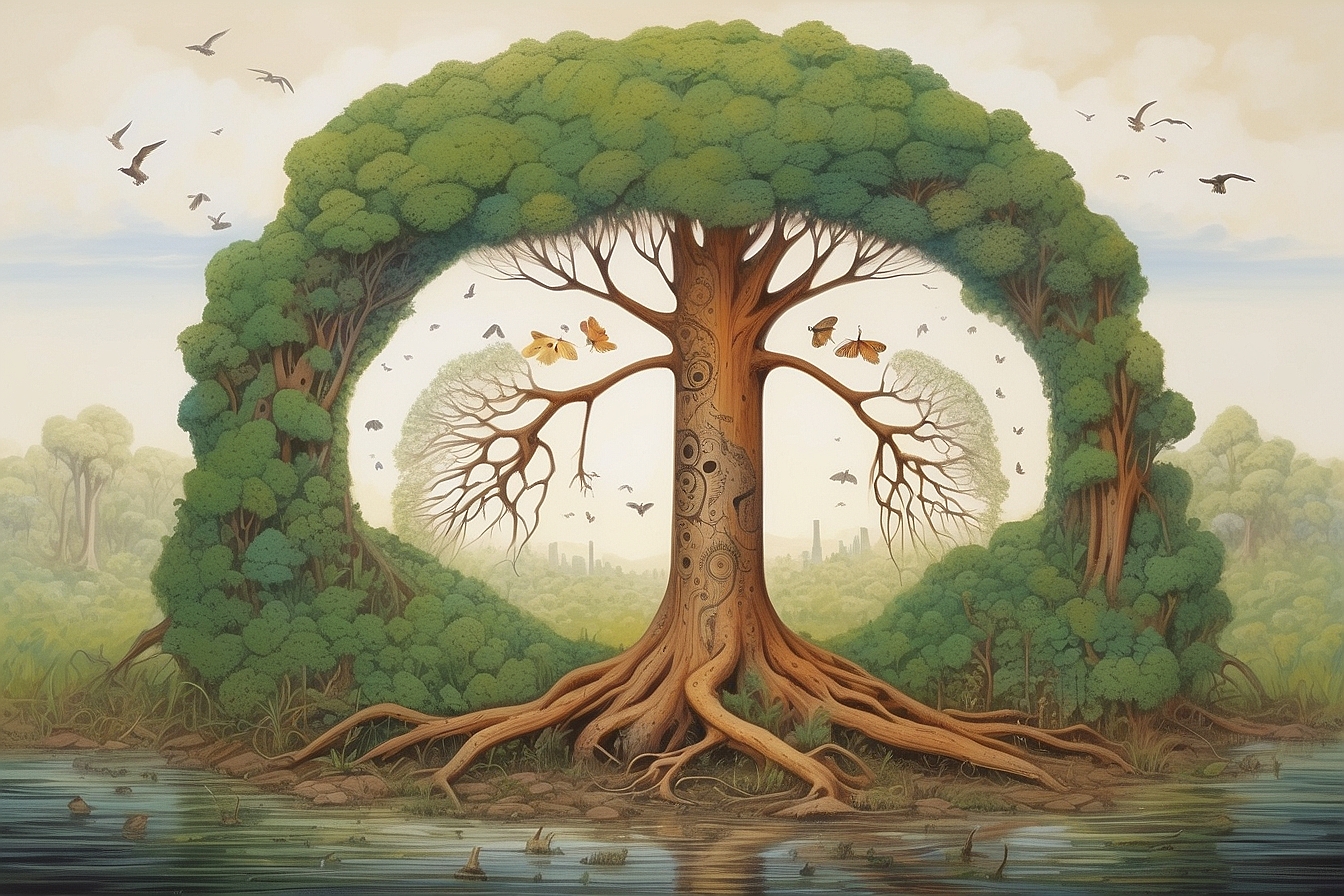In the famous story of Alice and Wonderland, the Walrus and the Carpenter coaxed a hoard of oysters to follow their lead. The Walrus and Carpenter fed on the oysters until, eventually, “they’d eaten everyone.” As the prose is so profoundly found in the story:
“O Oysters,” said the Carpenter,
“You had a pleasant run!
Shall we be trotting home again?”
But answer came there none—
And this was scarcely odd, because
They’d eaten every one.1
The plight of real-life oysters is shockingly similar. In the early 19th century, oysters were abundant in most of the bays and estuaries of the United States. The creatures were so easy to catch that they were cheap and mainly eaten by the working class. For example, in New York City on any day in the late 19th century, over six million oysters could be found on barges tied up along the city’s waterfront.
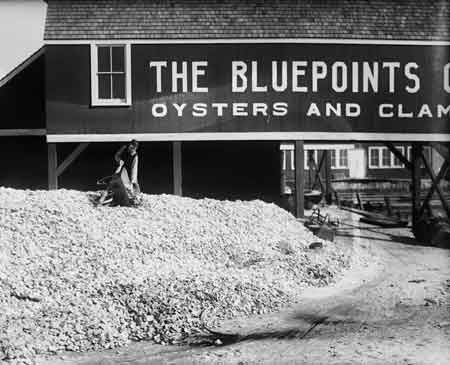 2
2
Eventually, rising demand exhausted many of the oyster beds in the U.S. To increase production, fishermen introduced foreign species, which brought disease. Disease combined with water pollution and increasing sedimentation from erosion destroyed most of the beds by the early 20th century. The oyster’s popularity as a delicious delicacy has put ever-increasing demands on wild oyster stocks and depleted the oyster reefs that once provided marine habitat and storm protection for many coastal cities around the world.3
The Importance of Oysters
Oysters are known as “keystone species” due to their disproportionately large effect on their surrounding environment relative to their abundance. Oysters provide a number of ecological services such as filtering water, providing habitat for other species, and protecting shorelines. Why is this 3-5 inch creature so important?4 Much of it has to do with its anatomy and behavior.
As a filter feeder, oysters can cycle up to 1.3 gallons of water an hour.5 In fact, when oyster populations were at their peak in the Chesapeake Bay, they could collectively filter the entire water volume of the Bay in three days!6 Oysters take in water over their gills by beating their cilia. Particles and plankton in the water column become trapped in the mucus of the oyster’s gill, and are then transported to the mouth, to be eaten digested, and expelled. This filtration process can help prevent eutrophication—explosions of algae growth—and can improve water quality and clarity. For more discussion on the state of our waters and eutrophication, read here .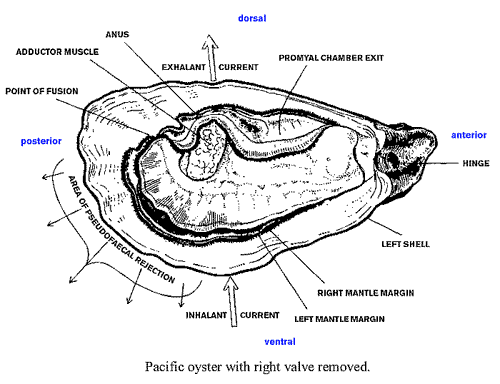 7
7
Oysters are also important to their surrounding environment because they grow in large groups, called beds or reefs. These reefs provide habitat for many marine species such as sea anemones, barnacles, and hooked mussels. These creatures provide food for larger animals including fish such as striped bass, black drum, and croakers.8 In addition, oyster reefs provide storm protection. An oyster can increase the surface area of a flat bottom 50-fold. This extra area is crucial for absorbing the extra wave energy from hurricanes and other strong storms.9
Gulf of Mexico
According to a 2010 study by Entergy Corporation and the America’s Wetland Foundation, if no steps are taken to counteract the effects of subsidence and and BP Deepwater Horizon oil spill , the gulf region is hurting for novel pathways to recovery.12
Oyster reefs provide a natural barrier against coastal erosion , and there is increasing evidence that natural solutions like mangroves and shellfish reefs can slow shoreline erosion and provide protection, while being economically efficient. Rather than build costly and high-maintenance sea walls and flood barriers, many cities and states are investing in oyster reef projects. The largest project to date is in Alabama. The Alabama Department of Conservation and Natural Resources and the Dauphin Island Sea Lab are erecting two new oyster reefs. The reef project is estimated to cost $4.28 million, will have a local output effect of $8.39 million, generate $2.38 million in earnings and 88 new jobs ☺ and will be constructed in lieu of replacing the old sea wall with a concrete barrier.13
https://web.archive.org/web/20160922193905if_/http://www.youtube.com/embed/ttldfWt5hrY 14
Chesapeake Bay
The largest oyster-producing body of water in the United States is located in Chesapeake Bay. However, due to overfishing and pollution, Chesapeake Bay oyster population levels are less than 1% of what they have been historically.15 As previously discussed, during the oyster population peak, oysters were able to filter excess nutrients from the Chesapeake estuary’s entire water volume every three days. With the number of oysters there are today, that filtration process now takes almost a full year.16
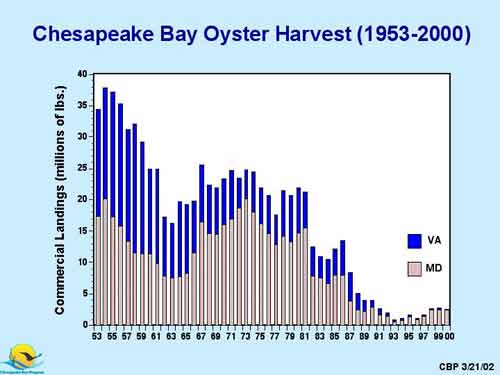 17
17
Several restoration projects were instituted over the last decade to try to meet the Chesapeake 2000 Bay Agreement, which sought to cut the amount of nitrogen entering the Bay by 19 million pounds a year by 2010:18
- The North Carolina Department of Environment and Natural Resources restored 10 acres of unproductive soft bottom habitat in the estuary of the Neuse River, Pamlico Sound, to turn it into a protected oyster reef sanctuary.19
- The U.S. Army Corps of Engineers dumped a huge number of old oyster shells into Virginia’s Great Wicomico River to create a new 100-acre reef system.20
- The Chesapeake Bay Foundation led an effort (supported in part through NOAA and The Nature Conservancy funding) to place more than 3 million oysters at the restored reef and in the Pinkatank River.21
San Francisco Bay
In the San Francisco Bay, the state Coastal Conservancy is spending $1.3 million on a five-year restoration project to help native oyster populations recover to pre-Gold Rush levels. Centuries ago, Olympia oysters were a staple for Native Americans up and down the West Coast. The Bay population of the oysters is estimated to have reached several million in the 19th century. However, once settlers started arriving in the area in droves, the oyster population from Alaska all the way down to Southern California crashed due to invasive species . In recent years the oyster population in the Bay numbers a measly 500,000.22
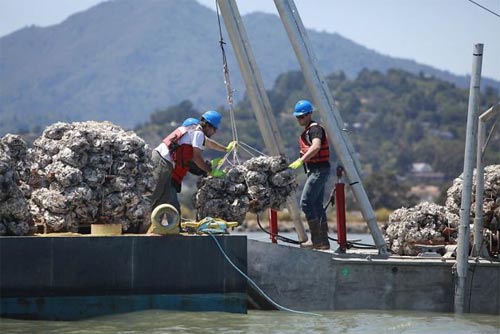 23
23
Project organizers have selected one site near San Rafael and one near Hayward where they will “essentially create oyster condominiums” by placing bundles of empty Japanese Pacific oyster shells in places where Olympia oyster larvae are looking for new homes. Each Japanese Pacific oyster shell can hold up to 30 native Olympia oysters, which will allow over a billion of these oysters to settle in the next year. Conservationists hope that the new oyster beds will provide local habitat, and will also help to mediate the effects of a erosion and other problems that could come with tidal surges and predicted rising sea levels. The results will “help guide other sub-tidal habitat restoration efforts in the future for the benefit of both people and nature.”24
New York / New Jersey Shore
The 14-foot flood surge that resulted from Hurricane Sandy in October 201225 demonstrates just how vulnerable many heavily-urbanized coastal regions are to large storms. Ecological barriers such as oyster reefs have disappeared from off the coast of New York and New Jersey. This is bad news considering that sea levels are expected to rise up to 15 inches by 2050. The number of people that are impacted by heavy storms – not to mention large scale disasters like Hurricane Sandy – is likely to increase exponentially over the next half century.26 Unfortunately, despite the dangers of hurricanes and flooding, oyster reef restoration has been stalled in New York and New Jersey harbors. In August 2010, the New Jersey Department of Environmental Protection banned research, restoration, and education projects using oysters in certain waters.27
In New York, the Hudson River Foundation, New York-New Jersey Bay Keeper, the Harbor School and even the Army Corps of Engineers have worked together to put out a handful of test reefs throughout the New York Harbor.28 Recently, Kate Orff, a landscape architect and assistant professor at Columbia University, proposed an oyster-bed rehabilitation project in an exhibition on rising sea levels at New York’s Museum of Modern Art.29 Orff said she was, “drawn to the idea of using a small organism on a wide scale—‘the oyster as a unit of change’—rather than relying solely on a monolithic structure.” Although each individual oyster does not make that much of a difference, collectively, they might.30

A reef constructed from rock and shell piles to host oyster growth, as seen in a rendering for a proposal in Brooklyn.31
Given that, as New York State’s Governor Andrew Cuomo jokingly put it, “we have a 100-year flood every two years now,” we’d better start planting a lot more oyster beds.32 Oyster reefs are infrastructure that we can create right now without billions of dollars being spent or a 50-year project timeframe.



